Reading Football Club has a history of finding talent on the cheap and developing them into top-level players. Kevin Doyle, Shane Long, Gylfi Sigurdsson and Steve Sidwell were all either picked up on the cheap or came through the academy before going on to bigger and better things. The club has failed to replicate these recruiting successes over the past couple of seasons, however, while they haven’t exactly set the EFL Championship on fire this season, there are signs that a new crop of young talented players are coming through in Berkshire. Andy Rinomhota, former Chelsea man John Swift and Michael Olise all look capable of developing into Premier League players.
However, one of the most intriguing and most certainly exciting to watch for Reading’s fans this season has been Liverpool loanee Ovie Ejaria. The former Rangers loan man is expected to be signed for around £3 million as part of the deal that took him to the Royals, and his performances would suggest this to be an excellent bit of business by the club.
Ejaria, though considered a quiet and shy individual, has quickly become a fans favourite at the Madjeski with his ability to beat players with a variety of skills. He looks far more confident than when he first joined Reading on loan halfway through the 2018/19 season. If we look at the data, his goals and assists are relatively low for a player of his talent, with just three apiece. At only 22 years of age, he has plenty of room to grow into a top-level player.
This tactical analysis, in the form of a scout report, will look at the strengths and weaknesses of the young midfielder’s game. Whether Liverpool will end up regretting giving Ejaria away is yet to be seen, however, if Reading can develop him further, they could certainly reap the rewards either on the pitch or financially.
Quick feet
Where Ejaria excels in his technical ability. Many a Championship defender has fallen victim to Ejaria’s long legs and trickery. He averages 6.45 dribbles per 90, with an impressive success rate of 59.62%. Reading manager Mark Bowen has been experimental in his formations, yet he always finds a place for Ejaria in the central areas. As the below heat map indicates, Ejaria operates in the half-space between an out and out left-winger and a central midfielder. He and John Swift are the players Bowen looks on to participate in the attacking phases, with the dribbling ability of Ejaria being key to this.
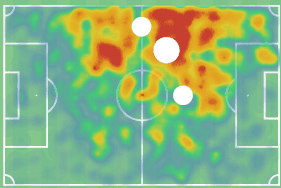
When we take a closer look at the dribbling data, we see that Ejaria is strong against all defensive players, be they holding midfielders, full-backs or centre-backs. What the below data also indicates is that while Ejaria tends to take most of his shots post dribbles in the central areas, two out of his three goals this season have come from that left-hand side. Bowen and the Reading staff will no doubt have this data available and be looking to encourage Ejaria to look for goalscoring opportunities in these areas.
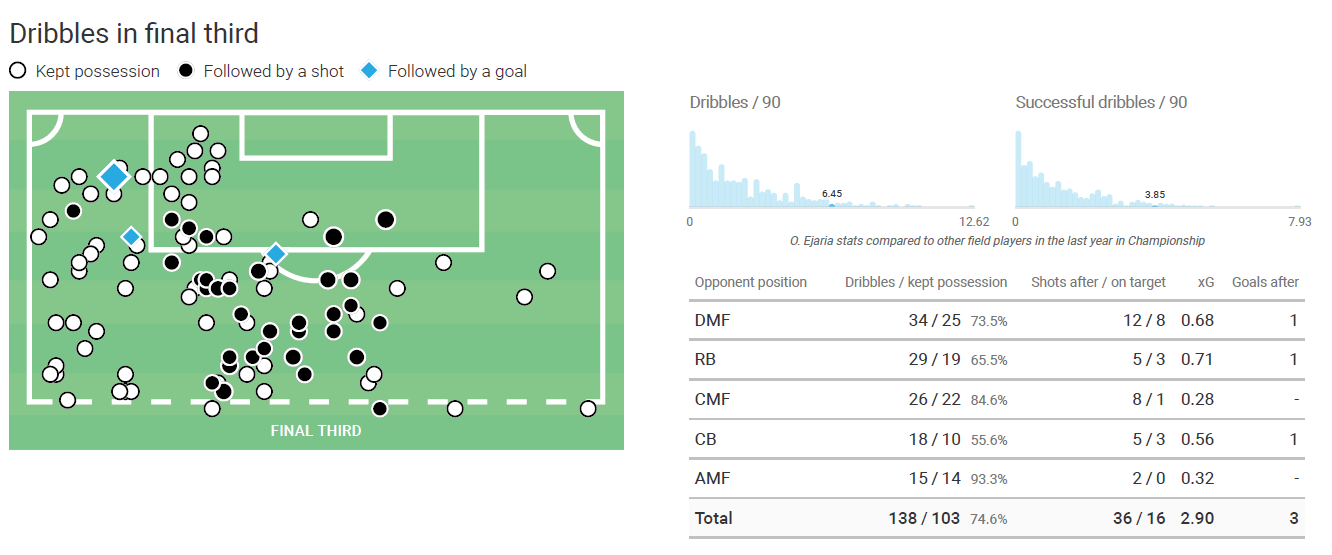
Returning to the above, we see the cluster of kept possession dribbles inside the penalty box on the left-hand side. Ejaria is incredibly good at beating players in tight areas, as we shall explore later. Being able to keep the ball in such good areas brings about the questions as to why, if he is able to keep the ball in these areas, has he only got three goals and three assists this season?
His xG for shots is good, so perhaps there is an area to work on there in terms of finishing. Yet while he has more or less met his xA of 3.27 this season. In order to explore this further, we need to look at the in-game data to see why Ejaria’s dribbling is not leading to more goals or assists.
If Ejaria can improve his shooting, he should certainly be able to take advantage of defender uncertainty to add to his tally. Defenders know that if you get too tight to the Nigerian he can use those quick feet to take you out of the game in a flash. Therefore, as we see below, defenders may look to drop off and give him more space, hoping to then allow for a double team or to give themselves more space to react to Ejaria.
Against Luton, we see an example of where Ejaria could take advantage of this. When he picks the ball up on the left-wing, there is plenty of space between him and the opposition defenders. Luton, while racing back towards their own goal, are in a decent position in that they have enough players to pick up the Reading runners. Therefore, the defender closest to Ejaria could press him more intensely, yet clearly Ejaria’s dribbling ability is in the back of his mind.
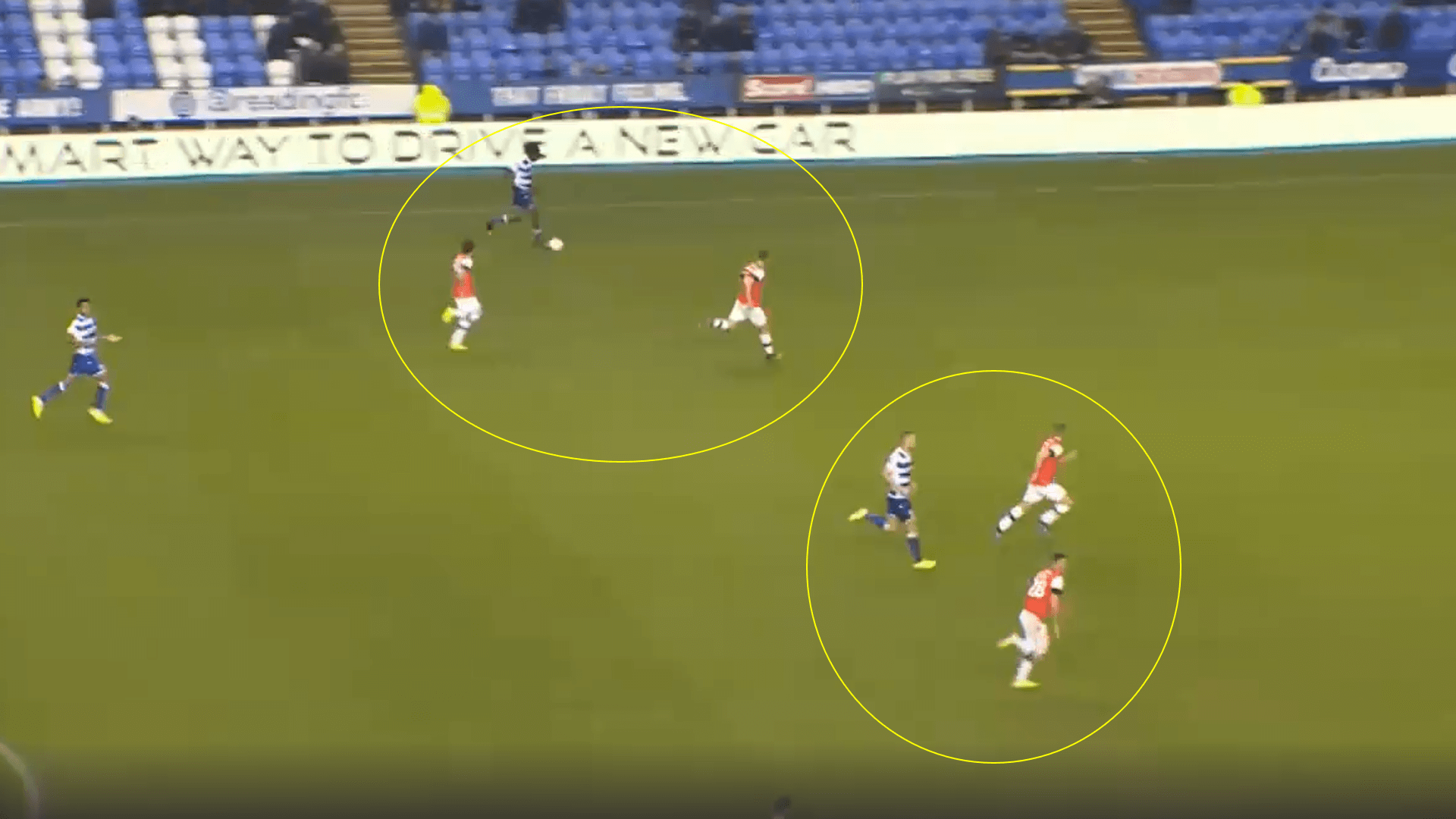
In the second image, we see that the defender closest has shifted inside and allowed his teammate to go to Ejaria, meaning that he has been able to progress the ball with little pressure. Fear of Ejaria’s dribbling ability has allowed him to progress into a dangerous area without having to use any of his tricks. As we saw from his dribbling pitch map, this is the area Ejaria has scored more of his goals from.
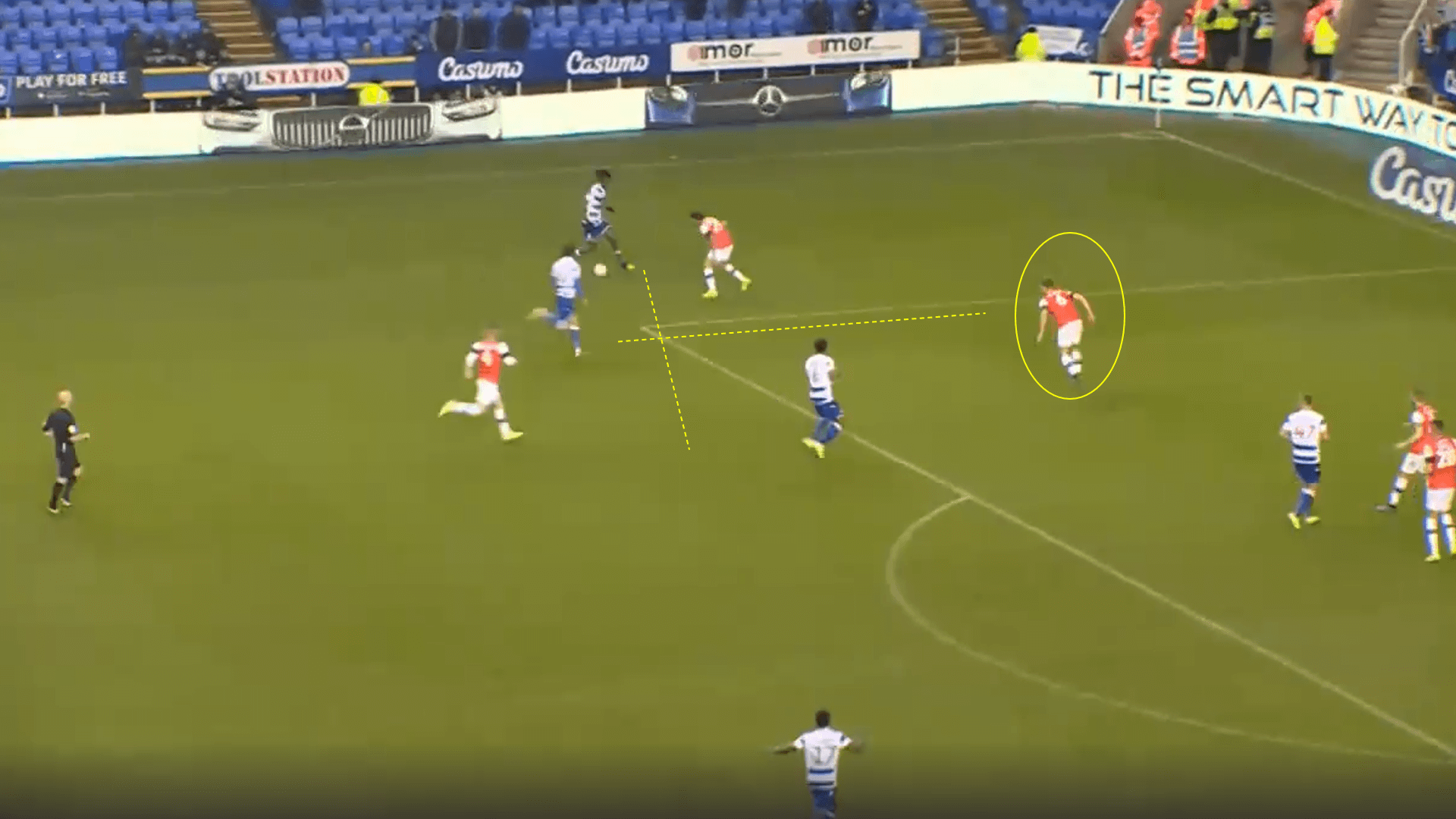
Again, the defender is afraid of closing Ejaria down too tightly so gives him space. Ejaria takes advantage of this and has enough space to cut in and produce a fine finish to score. His ability on the ball does allow him to shift and create such space even when surrounded by defenders. As the circle indicates, there is still a distance between the defender and Ejaria.
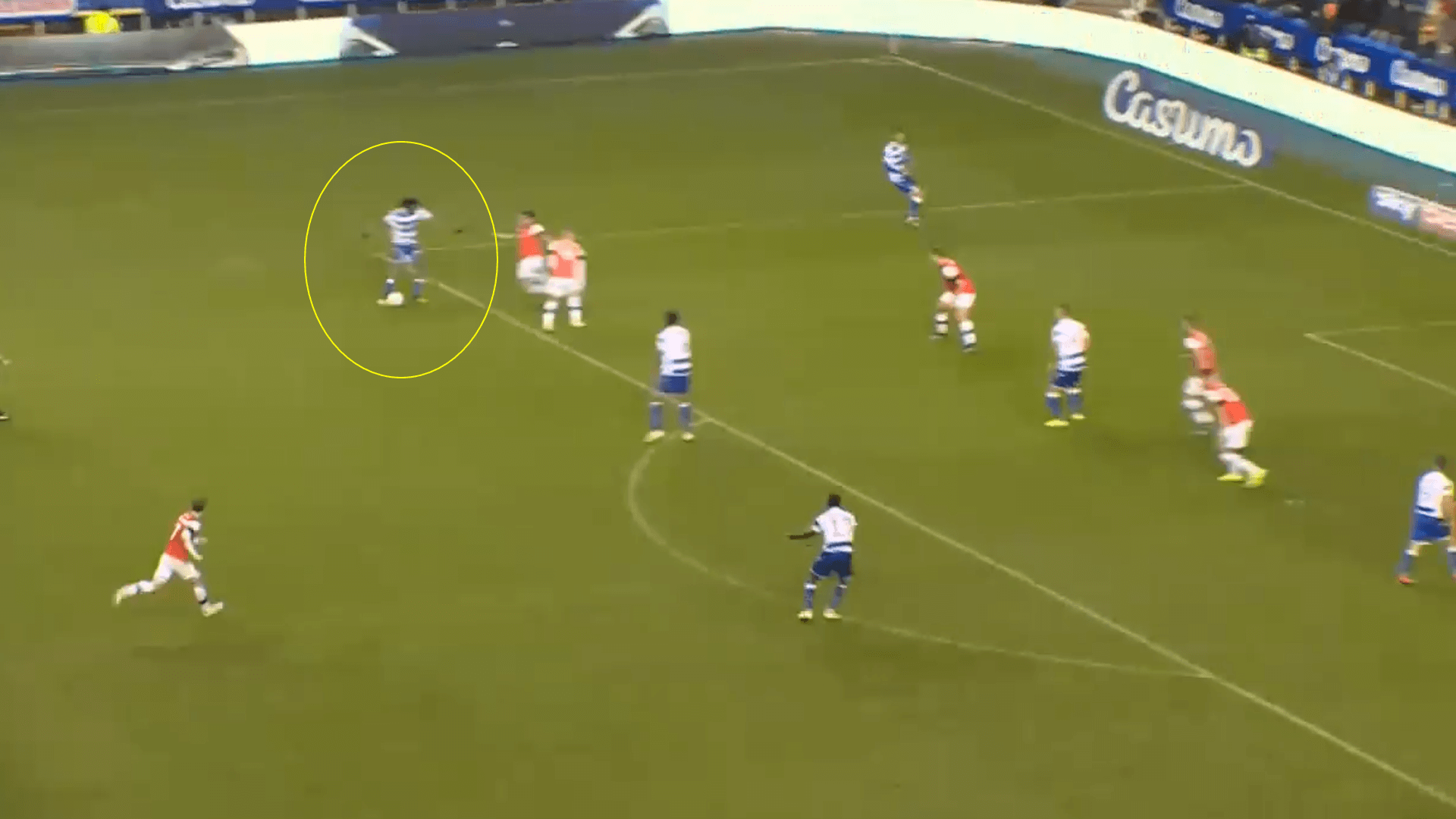
If he can increase his goal-scoring output, it will further add to the confusion defenders have. It will force the opposition to either mark him tightly and risk him using his quick feet to take them out of the game or sitting off giving him more shooting opportunities.
Decision making
While dribbling is a major strength of Ejaria’s which should by no means be discouraged from his game, not overdoing it is certainly something he will learn with greater experience. During a game there are instances where Ejaria will produce a sublime piece of skill to beat his man, opening up the opportunity to progress the attack through a pass or cross, only to return to dribble in order to beat his man again. The young midfielder will no doubt know what the better option would be, but playing with the freedom he does still leads to what many would consider the wrong decision.
It is also important to know when to dribble and when to look for a more simple option. There are many instances, however, where Ejaria looks to be in trouble and under pressure, only for him to use sublime skill to escape this pressure. Yet this is not always the case.
For example, in the game against Nottingham Forest, we see Ejaria pick the ball up deep in his own half, with Forest pushed up high. Most players in this position would look to clear the ball deep to allow the team to push up and reform their defensive set up.
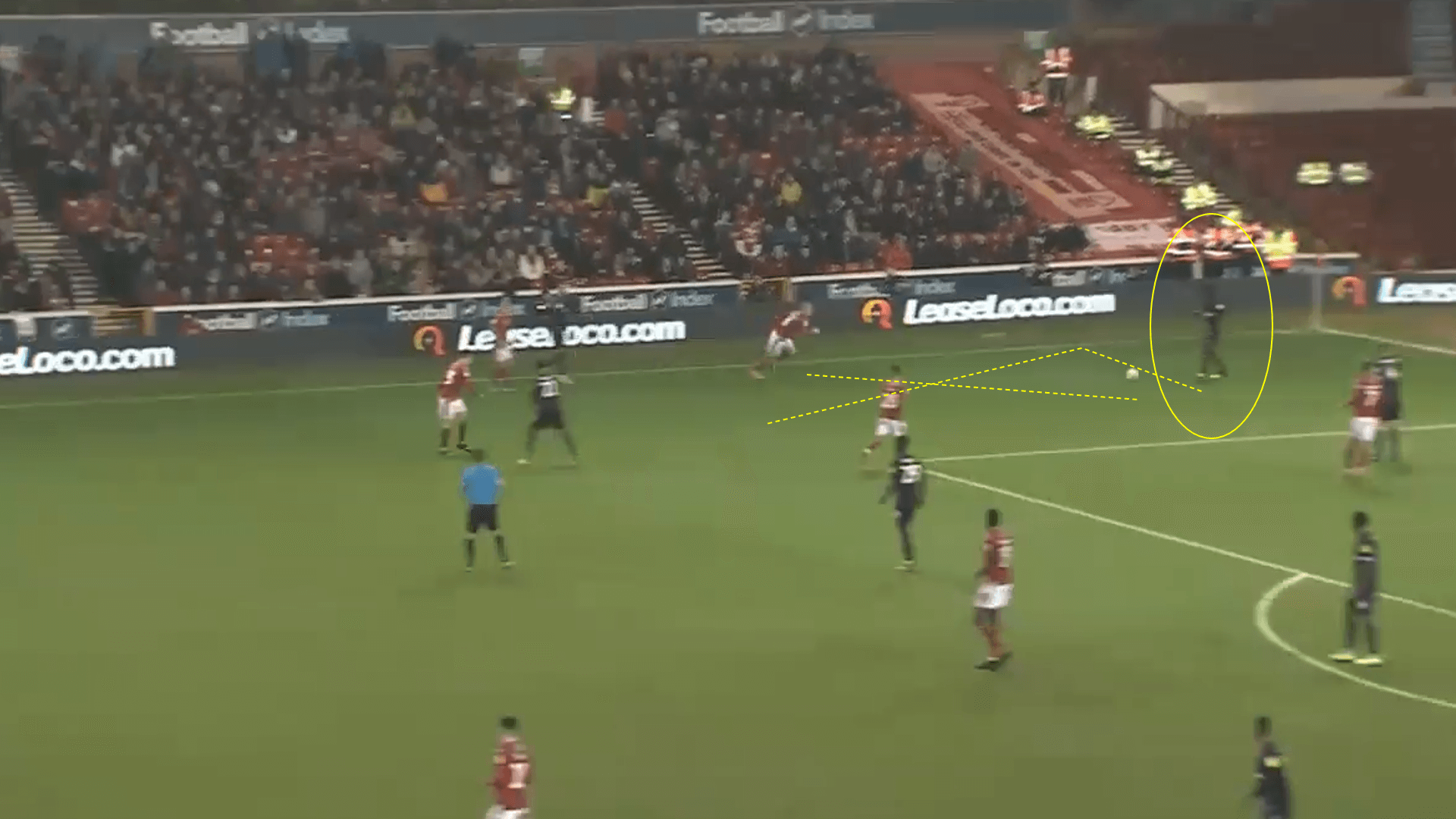
Yet in this second image, we see that Ejaria has kept the ball and encouraged the Forest player to press. Unlike in the Luton game, the Forest player pushes tight on to Ejaria who easily shifts it past him. While good skill, Ejaria has in this instance caused himself another problem, in that he now has limited options and has allowed Forest to squeeze him into an even more dangerous situation. While by no means a bad passer, with 33.32 averaged per 90 at an impressive success rate of 87.36%, any pass that isn’t a clearance in this instance is a risk.
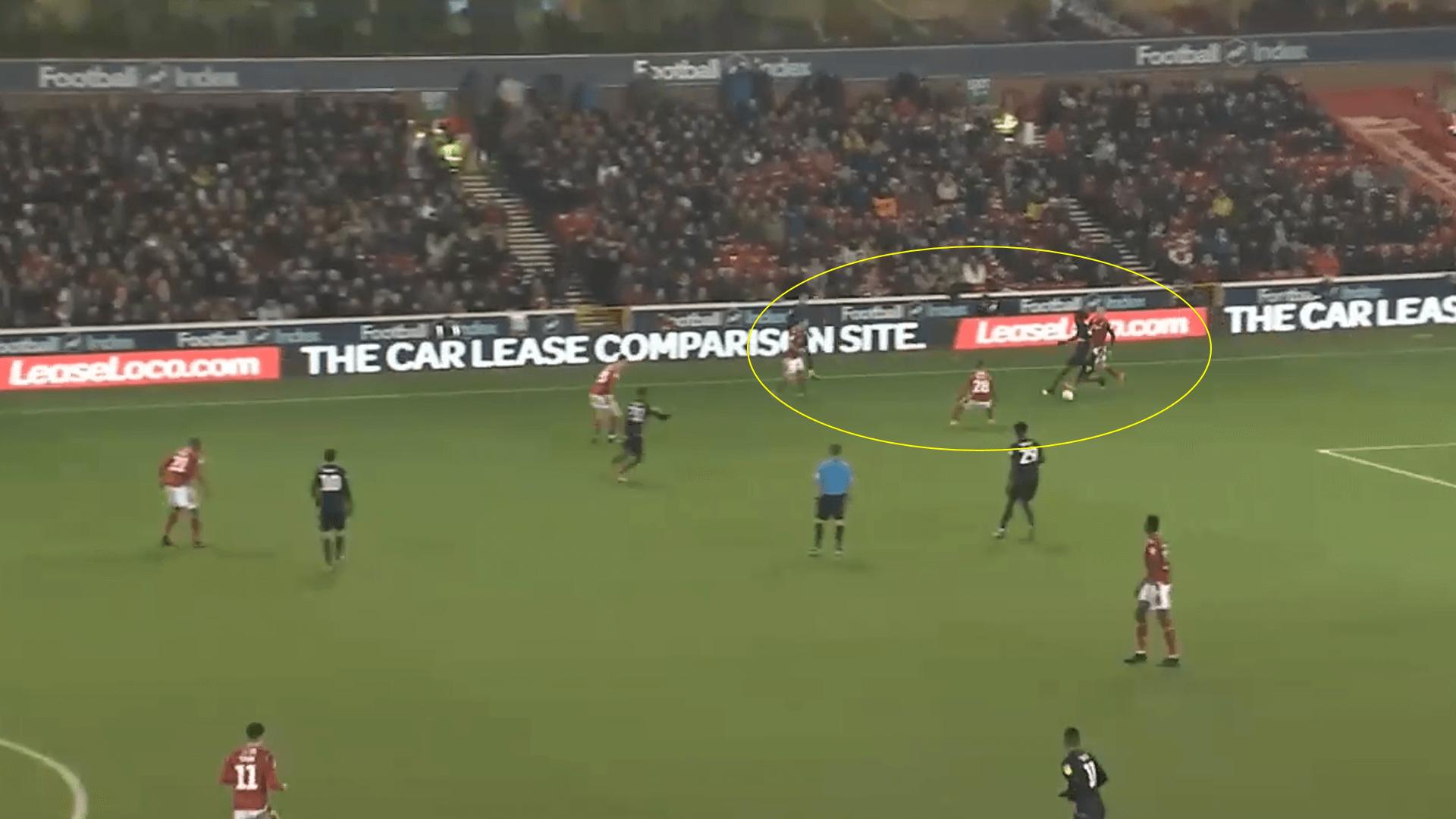
Instead of going long just to relieve pressure, Ejaria admirably attempts to transition the side from defence to attack. However, his attempted pass is easily intercepted as we see below, perhaps because the Reading striker anticipated a pass going in behind rather than to his feet. Despite a good piece of skill, the decision making of Ejaria here has put Reading under pressure.
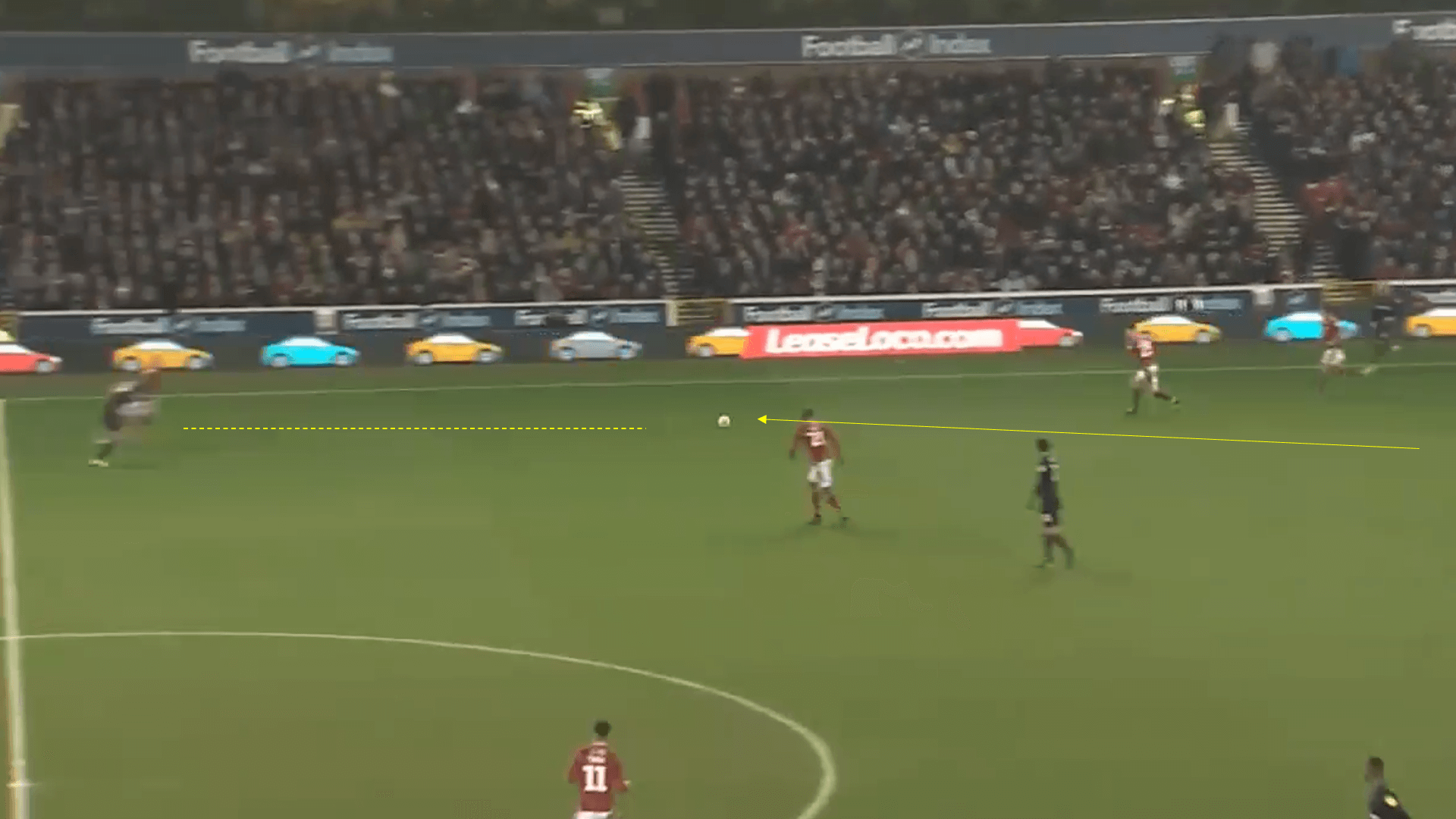
If we also return to the dribbling data in the final third above and add the below shots, we see another pattern emerge. Ejraia has taken more shots outside of the penalty area than inside with a low percentage on target. 32 shots with only 8 on target outside of the box at 25% accuracy and 1.34 xG. This is compared to 17 and 7 inside the box at 41.2% and an increased xG of 2.52. While two of his three goals have come from outside the area, perhaps Ejaria should be encouraged to look for a pass or even to force his way into the box more to increase his chances of scoring. On shot assists, Ejaria sits low with only 0.85 per match. If he converted some of these shots from outside the box into passes this may go up, as well as his assist numbers. Clearly this is also reliant on there being options when he is in these positions.
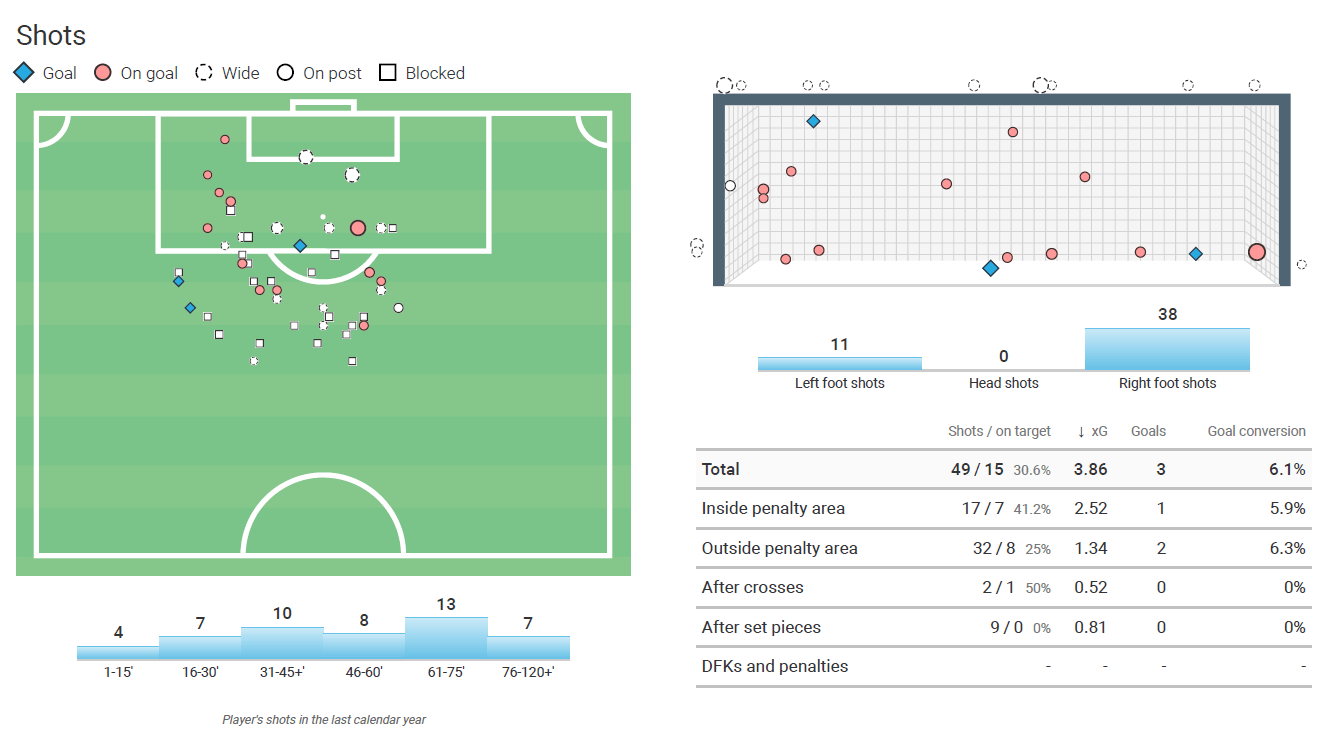
Good decision making usually comes with experience. At only 22 years of age Ejaria has plenty of development ahead and with an experienced coach such as Bowen in charge he certainly will be encouraged to analyse his game further and make the right decisions on the pitch.
At the defensive end
While Ejaria is predominantly used as an attacking player, he still has defensive responsibilities and is expected to contribute on that side of the ball. Ejarai’s physical attributes help him on the defensive end, he is tall and is able to use his length to his advantage. Much like a basketball player is judged by his ability to defend due to his wing-span, Ejaria long legs give him a similar advantage defensively, and he is often found using this to win the ball back for Reading.
Ejaria averages 5.39 duels per 90 with a success rate of 55.62, again highlighting that he is a reasonable defender. When we look at his recoveries, we see that he is averaging 5.82 per 90, alongside 2.7 counter-pressing recoveries.

When we look at this as part of the wider team data for Reading, they are one of the lowest teams for recoveries in the league. They average 74.49 per 90, which is interesting when you consider that the teams either side of them on the table, Derby Country and Queens Park Rangers, are both in the top 10 when it comes to ball possession. Reading, on the other hand, are down in 18th for ball possession with 47.2%.
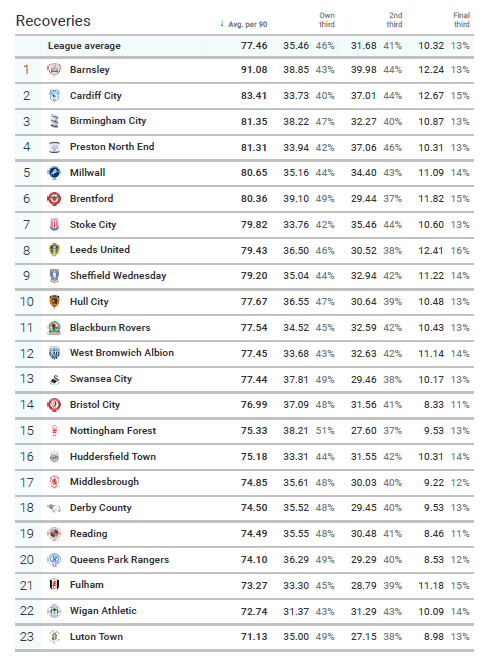
Therefore, when we analyse Ejaria on the defensive end and look at his recoveries, his numbers reflect the overall data for Reading. It is also difficult to judge his ability as a counter presser as this is not something Reading set out to do tactically. They are 20th out of 23 in terms of pressing intensity with 10.91. Reading like to sit back in their own half and force teams to play through them, rather than look to pressure the ball. Once again the data reflects this, with only 8.46 of their average recoveries per 90 coming in the final third, while 35.55 are in their own third.
Ejaria is, therefore, part of this defensive set up, where he is encouraged to maintain positional inflexibility in order to force the opposition to play through the team. With players like Ejaria and Swift, Bowen clearly realises that the defensive side of their games is far weaker than what they offer at the attacking end. Furthermore, Ejaria is wanted to be an option following a recovery, rather than the one recovering the ball. In an ideal world, the defensive midfielder will win the ball before finding Ejaria to quicken the transition from defence to attack.
Judging Ejaria defensively is difficult because of this tactical setup, yet his defensive duel percentage is good for a player with such an attacking mindset. His length also helps him when it comes to interception and ball retention. This is another area he can clearly improve on and no doubt will as he develops further, but the data within the overall team outlook is reasonably promising.
Conclusion
Ejaria is an exciting prospect well worth keeping an eye on next season. Reading will be desperate to keep him and develop him further. It is unlikely he returns to Liverpool, as he is unlikely to get the game time he needs to become a better player. If he can take the next step in 2020/21 at Reading, he could quickly become one of the best players in the Championship. More goals and assists will certainly make people sit up and take notice of this young Nigerian star.

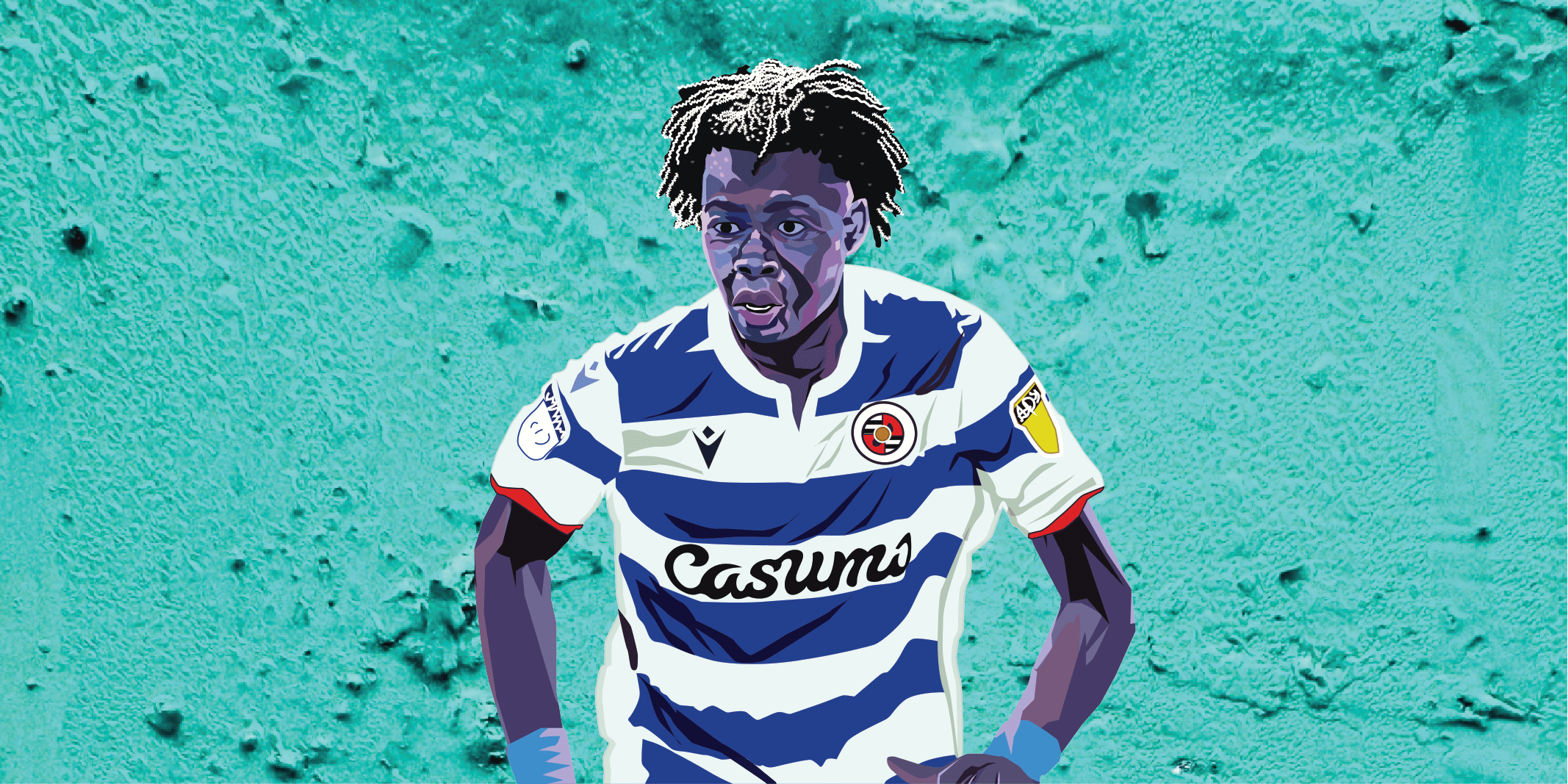



Comments